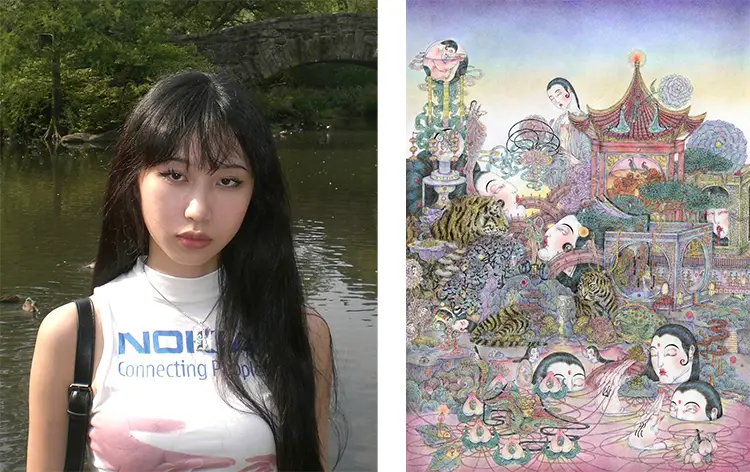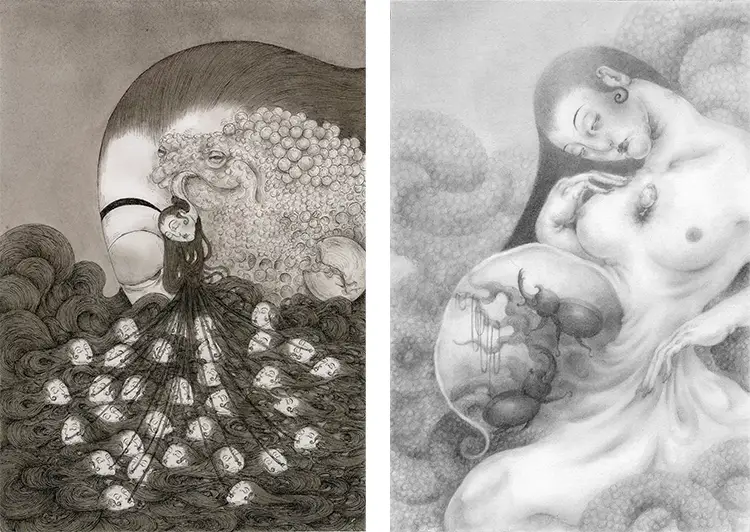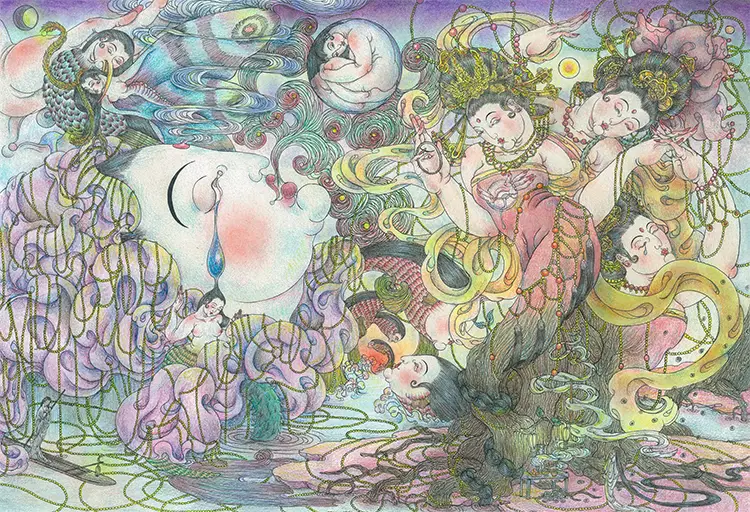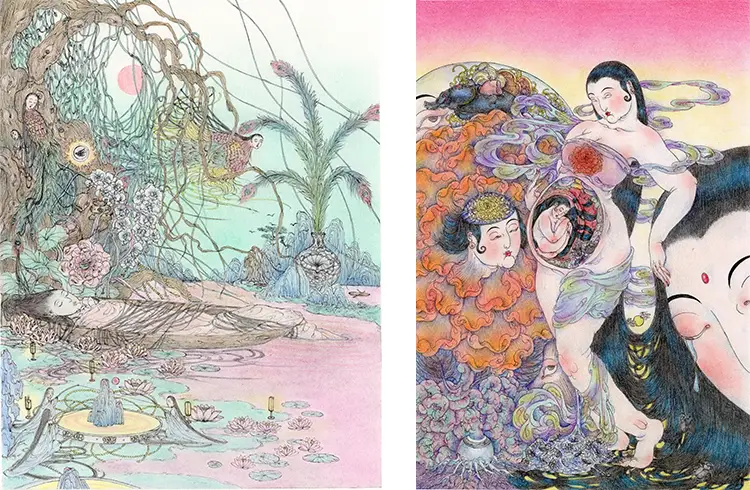“Drawing was just the only way I truly connected with the world.”
A Study in Shadows and Symbols
In the ever-evolving terrain of contemporary art, Mosaz Zijun Zhao stands apart with a practice rooted in introspection, mythology, and quiet disruption. Based in New York but originally from China, Mosaz approaches her work as an ongoing negotiation between memory and form. Her background in illustration serves as a foundation, yet her artistic journey has steadily expanded into a multifaceted practice that now includes drawing, occasional ventures into printmaking, and an ongoing curiosity about the intersection between internal narratives and collective experience. Her art doesn’t clamor for attention; instead, it invites prolonged contemplation, rewarding those who seek nuance over spectacle.
Her creative vision was significantly reshaped by a two-year departure from studio work, during which she immersed herself in philosophy, entomology, and historical studies. This academic and personal interlude altered her understanding of artistic authorship. Rather than seeing art as an isolated act of self-expression, she now views it as a dialogue between opposing forces: individual memory and cultural legacy, the material and the transcendent, life and death. These tensions permeate her compositions, often emerging through tightly rendered textures and monochrome palettes that leave room for both unease and serenity. For Mosaz, drawing is not merely visual but cognitive—a method of inquiry grounded in the senses.
Beyond her own studio, Mosaz has stepped into evaluative and curatorial roles that reflect her broader engagement with the global art ecosystem. In 2025, she served as a juror for the Sixth Genoa Biennale, and the year prior, she contributed to the Academic Committee of the China-Italy Contemporary Art Yearbook. These experiences have allowed her to explore the visual languages of other artists with a deeper sensitivity. By inhabiting both sides of the creative equation—as artist and as interpreter—she has honed a reflective practice that constantly reframes how she approaches her own work. It is this layered perspective that positions her not just as a creator but as a listener within the larger dialogue of contemporary art.

Mosaz: Where Stillness Disturbs
The tension between stillness and disquiet lies at the core of Mosaz’s artistic sensibility. Her work is primarily executed in monochrome, relying on intricate linework and subtle tonal shifts to build meditative yet emotionally charged compositions. She explores themes often shrouded in silence: death, dream logic, bodily estrangement, and the fragmentation of identity. The images may appear composed at first glance, but beneath their structural clarity is an undercurrent of disturbance. This juxtaposition is deliberate, evoking a space where discomfort becomes part of recognition.
One of her most significant works, A Joyful Funeral 1, exemplifies this paradox with haunting clarity. The piece unravels diagonally across the surface, starting with a diminutive mourning figure beside a tree stump and culminating in a towering Tree of Life composed of three divine heads. Behind this central axis lies an expansive ocean, representing rebirth. The deceased’s grief morphs into tears, which become a moth—a nod to Chinese folklore where moths are believed to be spirits of the departed. Yet the cycle does not end there; the moth is consumed by a bird, underscoring a quiet but unsettling narrative of transformation and erasure. This composition encapsulates Mosaz’s preoccupation with emotional dualities and the fragility of symbolic continuity.
In addition to her technical precision, what gives Mosaz’s work its emotional resonance is the balance between personal mythology and open interpretation. While her compositions are anchored in cultural memory and visual storytelling, they resist closure. Rather than providing answers, her pieces suggest multiple readings. This ambiguity is central to her practice. Her lines do not merely describe form—they trace states of consciousness, evoking a psychological space where identity dissolves and reconfigures. The viewer is invited not just to see, but to remember, to question, and to sit within the quiet turbulence her drawings evoke.

The Practice of Quiet Devotion
Mosaz’s working environment reflects the same subtle intensity found in her art. She prefers long, undisturbed sessions often carried out late at night, when the world outside recedes and concentration deepens. Her ideal workspace includes a large desk, natural light during the day, and silence or carefully chosen ambient soundscapes, sometimes even opera. The room is populated with plants, books, and insect specimens—objects that echo the recurring motifs in her art. These elements form a sanctuary where distraction is minimized, and mental focus can extend across hours. For Mosaz, this isolation is not just a preference but a requirement for accessing the depth her work demands.
Her choice of medium reflects a strong sense of fidelity to line and gesture. Drawing with pencil and ink feels to her like “thinking with hands,” a process that marries instinct and structure. While she has explored other disciplines—painting, sculpture, and more recently, printmaking—none have matched the clarity and immediacy she finds in drawing. Each stroke is intentional, yet never rigid. There’s a rhythm to her mark-making that resembles breathing, a cadence that mirrors the way thought and memory surface and fade. This organic process is central to her approach, grounding her more conceptual concerns in a tangible act of making.
Despite her isolationist working habits, Mosaz is not disconnected from the world. Her inspiration stems not from any singular artist or movement but from an internal reservoir of observation and metamorphosis. Experiences, memories, dreams, and even biological curiosities feed into her visual language. Her interest in insects, for example, is not simply aesthetic. It intersects with her fascination with transformation, decay, and cyclical time. These recurring themes operate as conceptual anchors, giving structure to her evolving practice. Rather than looking outward to emulate, Mosaz turns inward to observe, and in doing so, creates art that resonates with universal, though often unspoken, emotional states.

Mosaz: Through the Glass, Unbroken
At the core of Mosaz’s current creative inquiry is an image she cannot shake: a glass dome surrounding her. This metaphorical boundary encapsulates a sensation she describes not as physical, but as psychic—a barrier between herself and the outer world that feels both protective and limiting. While still in a formative stage, this concept represents a turning point in her practice, signaling a desire to shift the way she constructs and experiences her own work. The dome is not yet an artwork but an internal architecture she is learning to navigate and possibly dismantle. It speaks to a broader longing: to reach beyond previous modes of creation without discarding the introspective essence that defines her vision.
This emerging project may never manifest as a traditional installation or series, but its influence is already visible in her thinking. Mosaz has begun to speak about art-making not as producing images, but as puncturing barriers—between the body and its surroundings, between the self and the collective. This reframing signals a quiet but determined evolution in her methodology. Whether through thematic expansion or experimental form, she is questioning the invisible structures that shape both perception and process. It’s a form of internal cartography, where drawing becomes a way to map the edges of containment and possibility.
Even as she leans into this threshold, Mosaz remains anchored by the same guiding principles that have shaped her work from the beginning. She continues to explore how loss, memory, and transformation can be expressed through the interplay of line, tone, and space. Yet the intention behind these choices is subtly shifting. The dome is not just an obstacle; it is also a container of insight. By approaching it with awareness, she opens a new space within her practice—one that holds both vulnerability and agency. This inward expansion hints at a future body of work not yet fully formed, but already vibrating with potential.








